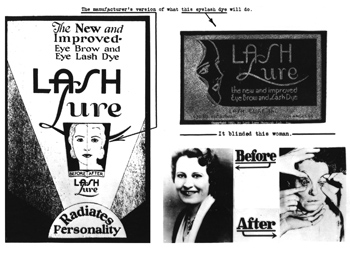For Consumers
Bad Reaction to Cosmetics? Tell FDA
 Lash Lure blinded at least one woman and caused burns and other severe reactions in others when it was used as an eyelash and eyebrow dye in the 1920s and ‘30s. At the time, it was difficult to get an unsafe product off the market. This and other FDA images available on Flickr. |
 Get Consumer Updates by E-mail
Get Consumer Updates by E-mail
 Share copies of this article (786 KB)
Share copies of this article (786 KB)
You break out in a head-to-toe rash after applying a sunless tanning lotion. Your son’s skin is red and blotchy after he gets his face painted at the school carnival. Your daughter’s scalp is burned after using a hair relaxer.
If you’ve had a negative reaction to a beauty, personal hygiene, or makeup product, the Food and Drug Administration (FDA) wants to hear from you.
From morning until night—styling our hair for work to showering before bed—Americans depend upon personal care products. Most are safe, but some cause problems, and that’s when FDA gets involved.
“Even though these products are widely used, most don’t require FDA approval before they’re sold in stores, salons, and at makeup counters,” says Linda Katz, M.D., director of the agency’s Office of Cosmetics and Colors. “So, consumers are one of FDA’s most important resources when it comes to identifying problems.”
The federal Food, Drug, and Cosmetic Act defines “cosmetics” as products that are intended to be applied to the body “for cleansing, beautifying, promoting attractiveness, or altering the appearance.” But the legal definition includes items that most Americans might not ordinarily think of as cosmetics, including:
- face and body cleansers
- deodorants
- moisturizers and other skin lotions and creams
- baby lotions and oils
- hair care products, dyes, conditioners, straighteners, perms
- makeup
- hair removal creams
- nail polishes
- shaving products
- perfumes and colognes
- face paints and temporary tattoos
- permanent tattoos and permanent makeup
What to Report
Katz says consumers should contact FDA if they experience a rash, hair loss, infection, or other problem—even if they didn’t follow product directions. FDA also wants to know if a product has a bad smell or unusual color—which could signal contamination—or if the item’s label is incomplete or inaccurate.
If you have any concerns about a cosmetic, contact MedWatch, FDA’s problem-reporting program, on the Web or at 1-800-332-1088; or contact the consumer complaint coordinator in your area.
When you contact FDA, include the following information in your report:
- the name and contact information for the person who had the reaction;
- the age, gender, and ethnicity of the product’s user;
- the name of the product and manufacturer;
- a description of the reaction—and treatment, if any;
- the healthcare provider’s name and contact information, if medical attention was provided; and
- when and where the product was purchased.
And be sure to give the age, gender, and ethnicity of the person who had the reaction, says FDA scientist Wendy Good, Ph.D. Good, who analyzes reports about problems with cosmetics, says that information is important because it can help scientists spot trends.
When a consumer report is received, FDA enters the information into a database of negative reactions. Experts then look for reports related to the same product or similar ones. FDA scientists will use the information to determine if the product has a history of problems and represents a public health concern that needs to be addressed.
If you file a consumer report, your identity will remain confidential.
"Cosmetics are usually safe, but when they aren't, consumer reporting is essential so FDA can take action when appropriate,” Katz says. Those actions could—depending upon the product and the problem—range from issuing a consumer safety advisory to taking legal action.
This article appears on FDA's Consumer Updates page, which features the latest on all FDA-regulated products.
Posted Mar. 28, 2011








